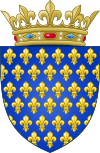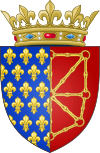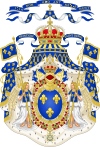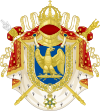List of French monarchs

Ruled from the start of the Frankish Kingdom in 486 to 1870. During most of its history, France was ruled by kings. Four Carolingian monarchs were also Roman Emperors and the Bonapartes were Emperors of the French.
This article lists all rulers to have held the title "King of Franks", "King of France", "King of the French" or "Emperor of the French".
The title "King of the Franks" was in use until the reign of Philip II. During the short time when the French Constitution of 1791 was in effect (1791–1792) and after the July Revolution in 1830, the style "King of the French" was used instead of "King of France (and Navarre)".
In addition to the Kingdom of France, there were also two French Empires. The First French Empire was from 1804 to 1815. It was founded and ruled by Napoleon I. The Second French Empire was from 1852 to 1870. It was founded and ruled by his nephew Napoleon III Then 3rd 4th and 5th republic formed
Earlier Monarchs[change | change source]
| Picture | Name | Reign | Title |
|---|---|---|---|

|
Pharamond / Faramund | c. 392 - 428 | Gallic King |
Merovingian Dynasty (428–751)[change | change source]
The name of France comes from the Germanic tribe known as the Franks. The Merovingian kings began as chieftains. The oldest known was Chlodio. Clovis I was the first of these to rise to true kingship. After his death, his kingdom was split between his sons into Soissons (Neustria), Paris, Orléans (Burgundy), and Metz (Austrasia). Several Merovingian monarchs brought back together the Frankish kingdoms and took the title of "King of the Franks". But upon their deaths, according to Frankish custom, the kingdom would often be split once again between their sons.
| Portrait | Name | King From | King Until | Relationship with Predecessor(s) | Title |
|---|---|---|---|---|---|

|
Chlodio the Longhair (Clodion le Chevelu) |
428 | 445/448 | • Son of Theudemeres | King of the Salian Franks (Roi des Francs saliens) |

|
Merovech (Mérovée) |
445/448 | 457 | • Son of Chlodio | King of the Salian Franks (Roi des Francs saliens) |

|
Childeric I (Childéric Ier) |
457 | 481/482 | • Son of Merovech | King of the Salian Franks (Roi des Francs saliens) |

|
Clovis I (Clovis Ier) |
481/482 | 511 | • Son of Childeric I | King of the Franks (Roi des Francs) |

|
Childebert I (Childebert Ier) |
511 | 23 December 558 | • Son of Clovis I | King of Paris (Roi de Paris) |

|
Chlothar I the Old (Clotaire Ier le Vieux) |
23 December 558 | 29 November 561 | • Son of Clovis I • Younger brother of Childebert I |
King of the Franks (Roi des Francs) |

|
Charibert I (Caribert Ier) |
29 November 561 | 567 | • Son of Chlothar I | King of Paris (Roi de Paris) |

|
Chilperic I (Chilpéric Ier) |
567 | 584 | • Son of Chlothar I • Younger brother of Charibert I |
King of Paris (Roi de Paris) King of Neustria (Roi de Neustrie) |

|
Chlothar II the Great, the Young (Clotaire II le Grand, le Jeune) |
584 | 18 October 629 | • Son of Chilperic I | King of Neustria (Roi de Neustrie) King of Paris (Roi de Paris) (595–629) King of the Franks (Roi des Francs) (613–629) |

|
Dagobert I (Dagobert Ier) |
18 October 629 | 19 January 639 | • Son of Chlothar II | King of the Franks (Roi des Francs) |
| Clovis II the Lazy (Clovis II le Fainéant) |
19 January 639 | 31 October 657 | • Son of Dagobert I | King of Neustria and Burgundy (Roi de Neustrie et de Bourgogne) | |

|
Chlothar III (Clotaire III) |
31 October 657 | 673 | • Son of Clovis II | King of Neustria and Burgundy (Roi de Neustrie et de Bourgogne) King of the Franks (Roi des Francs) (657–663) |

|
Childeric II (Childéric II) |
673 | 675 | • Son of Clovis II • Younger brother of Chlothar III |
King of the Franks (Roi des Francs) |

|
Theuderic III (Thierry III) |
675 | 691 | • Son of Clovis II • Younger brother of Childeric II |
King of Neustria (Roi de Neustrie) King of the Franks (Roi des Francs) (687–691) |

|
Clovis IV (Clovis IV) |
691 | 695 | • Son of Theuderic III | King of the Franks (Roi des Francs) |

|
Childebert III the Just (Childebert III le Juste) |
695 | 23 April 711 | • Son of Theuderic III • Younger brother of Clovis IV |
King of the Franks (Roi des Francs) |

|
Dagobert III | 23 April 711 | 715 | • Son of Childebert III | King of the Franks (Roi des Francs) |

|
Chilperic II (Chilpéric II) |
715 | 13 February 721 | • Probably son of Childeric II | King of Neustria and Burgundy (Roi de Neustrie et de Bourgogne) King of the Franks (Roi des Francs) (719–721) |
The last Merovingian kings, known as the lazy kings (rois fainéants), did not hold any real political power. The Mayor of the Palace governed instead. When Theuderic IV died in 737, Mayor of the Palace Charles Martel left the throne vacant and continued to rule until his own death in 741. His sons Pepin and Carloman briefly brought back the Merovingian dynasty by raising Childeric III to the throne in 743. In 751, Pepin deposed Childerich and took the throne.
| Portrait | Name | King From | King Until | Relationship with Predecessor(s) | Title |
|---|---|---|---|---|---|

|
Childeric III (Childéric III) |
743 | November 751 | • Son of Chilperic II or of Theuderic IV | King of the Franks (Roi des Francs) |
Carolingian Dynasty (751–987)[change | change source]
Three of the twelve kings during the 147-year Carolingian Dynasty – Odo, his brother Robert I and Robert's son in law Raoul/Rudolph – were not from the Carolingian Dynasty but from the rival Robertian Dynasty. The Robertian Dynasty became the Capetian Dynasty with when Hugh Capet took the throne in 987.
| Portrait | Name | King From | King Until | Relationship with Predecessor(s) | Title |
|---|---|---|---|---|---|

|
Pepin the Younger (Pépin le Bref) |
752 | 24 September 768 | • Son of Charles Martel | King of the Franks (Roi des Francs) |

|
Carloman I | 24 September 768 | 4 December 771 | • Son of Pepin the Short | King of the Franks (Roi des Francs) |

|
Charlemagne (Charles I) | 24 September 768 | 28 January 814 | • Son of Pepin the Short | King of the Franks (Roi des Francs) Emperor of the Romans (Imperator Romanorum) (800–814) |

|
Louis I the Pious, the Debonaire (Louis Ier le Pieux, le Débonnaire) |
28 January 814 | 20 June 840 | • Son of Charlemagne | King of the Franks (Roi des Francs) Emperor of the Romans (Imperator Romanorum) |

|
Charles II the Bald (Charles II le Chauve) |
20 June 840 | 6 October 877 | • Son of Louis I | King of the Franks (Roi des Francs) Emperor of the Romans (Imperator Romanorum) (875–877) |

|
Louis II the Stammerer (Louis II le Bègue) |
6 October 877 | 10 April 879 | • Son of Charles II | King of the Franks (Roi des Francs) |

|
Louis III | 10 April 879 | 5 August 882 | • Son of Louis II | King of the Franks (Roi des Francs) |

|
Carloman II | 5 August 882 | 6 December 884 | • Son of Louis II | King of the Franks (Roi des Francs) |

|
Charles the Fat (Charles le Gros) |
20 May 885 | 13 January 888 | • Son of Louis the German • Cousin of Louis II and Carloman II • Grandson of Louis I the Pious |
King of the Franks (Roi des Francs) Emperor of the Romans (Imperator Romanorum) (881–887) |

|
Odo of Paris (Eudes de Paris) |
29 February 888 | 1 January 898 | • Son of Robert the Strong (Robertians) • Elected king against young Charles III. |
King of the Franks (Roi des Francs) |

|
Charles III the Simple (Charles III le Simple) |
28 January 893 | 30 June 922 | • Posthumous son of Louis II • Younger half-brother of Louis III and Carloman II |
King of the Franks (Roi des Francs) |

|
Robert I (Robert Ier) |
30 June 922 | 15 June 923 | • Son of Robert the Strong (Robertians) • Younger brother of Odo |
King of the Franks (Roi des Francs) |

|
Rudolph (Raoul de France) |
13 July 923 | 14 January 936 | • Son of Richard, Duke of Burgundy (Bosonids) • Son-in-law of Robert I |
King of the Franks (Roi des Francs) |

|
Louis IV from overseas (Louis IV d'Outremer) |
19 June 936 | 10 September 954 | • Son of Charles III | King of the Franks (Roi des Francs) |

|
Lothair (Lothaire de France) |
12 November 954 | 2 March 986 | • Son of Louis IV | King of the Franks (Roi des Francs) |

|
Louis V the Lazy (Louis V le Fainéant) |
8 June 986 | 22 May 987 | • Son of Lothair | King of the Franks (Roi des Francs) |
|}
Capetian Dynasty (987–1792)[change | change source]
The Capetian Dynasty, the male-line descendants of Hugh Capet, ruled France from 987 to 1792 and again from 1814 to 1848. The branches of the dynasty which ruled after 1328 are generally called Valois and Bourbon.
Direct Capetians (987–1328)[change | change source]
| Portrait | Coat of Arms | Name | King From | King Until | Relationship with Predecessor(s) | Title |
|---|---|---|---|---|---|---|
 |
Hugh Capet (Hugues Capet) |
3 July 987 | 24 October 996 | • Grandson of Robert I | King of the Franks (Roi des Francs) | |
| Robert II the Pious, the Wise (Robert II le Pieux, le Sage) |
24 October 996 | 20 July 1031 | • Son of Hugh Capet | King of the Franks (Roi des Francs) | ||
 |
Henry I (Henri Ier) |
20 July 1031 | 4 August 1060 | • Son of Robert II | King of the Franks (Roi des Francs) | |
 |
Philip I (Philippe Ier l' Amoureux) |
4 August 1060 | 29 July 1108 | • Son of Henry I | King of the Franks (Roi des Francs) | |
 |
Louis VI the Fat (Louis VI le Gros) |
29 July 1108 | 1 August 1137 | • Son of Philip I | King of the Franks (Roi des Francs) | |
 |
 |
Louis VII the Young (Louis VII le Jeune) |
1 August 1137 | 18 September 1180 | • Son of Louis VI | King of the Franks (Roi des Francs) |
 |
 |
Philip II Augustus (Philippe II Auguste) |
18 September 1180 | 14 July 1223 | • Son of Louis VII | King of the Franks (Roi des Francs) King of France (Roi de France) |
 |
 |
Louis VIII the Lion (Louis VIII le Lion) |
14 July 1223 | 8 November 1226 | • Son of Philip II Augustus | King of France (Roi de France) |
 |
 |
Louis IX the Saint (Saint Louis) |
8 November 1226 | 25 August 1270 | • Son of Louis VIII | King of France (Roi de France) |
 |
 |
Philip III the Bold (Philippe III le Hardi) |
25 August 1270 | 5 October 1285 | • Son of Louis IX | King of France (Roi de France) |
 |
Philip IV the Fair (Philippe IV le Bel) |
5 October 1285 | 29 November 1314 | • Son of Philip III | King of France and of Navarre (Roi de France et de Navarre) | |
 |
 |
Louis X the Quarreller (Louis X le Hutin) |
29 November 1314 | 5 June 1316 | • Son of Philip IV | King of France and of Navarre (Roi de France et de Navarre) |
 |
 |
John I the Posthumous (Jean Ier le Posthume) |
15 November 1316 | 20 November 1316 | • Son of Louis X, Crowned on Birth, died aged 5 days only. | King of France and of Navarre (Roi de France et de Navarre) |
 |
 |
Philip V the Tall (Philippe V le Long) |
20 November 1316 | 3 January 1322 | • Son of Philip IV • Younger brother of Louis X |
King of France and of Navarre (Roi de France et de Navarre) |
 |
 |
Charles IV the Fair (Charles IV le Bel) |
3 January 1322 | 1 February 1328 | • Son of Philip IV • Younger brother of Philip V |
King of France and of Navarre (Roi de France et de Navarre) |
Not listed above are Hugh Magnus, eldest son of Robert II, and Philip of France, eldest son of Louis VI. Both were co-Kings with their fathers but died before them. Because neither Hugh nor Philip were sole or senior king in their own lifetimes, they are usually not listed as Kings of France.
House of Valois (1328–1589)[change | change source]
| Portrait | Coat of Arms | Name | King From | King Until | Relationship with Predecessor(s) | Title | |||||||
|---|---|---|---|---|---|---|---|---|---|---|---|---|---|
 |
 |
Philip VI of Valois, the Fortunate (Philippe VI de Valois, le Fortuné) |
1 April 1328 | 22 August 1350 | • Son of Charles of Valois, who was son of Philip III | King of France (Roi de France) | |||||||
 |
 |
John II the Good (Jean II le Bon) |
22 August 1350 | 8 April 1364 | • Son of Philip VI | King of France (Roi de France) | |||||||
 |
 |
Charles V the Wise (Charles V le Sage) |
8 April 1364 | 16 September 1380 | • Son of John II | King of France (Roi de France) | |||||||
 |
 |
Charles VI the Beloved, the Mad (Charles VI le Bienaimé, le Fol) |
16 September 1380 | 21 October 1422 | • Son of Charles V | King of France (Roi de France) | |||||||
| Henry VI of England, Shrewsbury book.jpg | Henry VI of England
(claimant) |
21 October 1422 | 19 October 1453 | Maternal grandson of Charles VI, recognized as heir after the Treaty of Troyes of 21 May 1420 | |||||||||
 |
 |
Charles VII the Victorious, the Well-Served (Charles VII le Victorieux, le Bien-Servi) |
21 October 1422 | 22 July 1461 | • Son of Charles VI | King of France (Roi de France) | |||||||
 |
 |
Louis XI the Prudent, the Universal Spider (Louis XI le Prudent, l'Universelle Aragne) |
22 July 1461 | 30 August 1483 | • Son of Charles VII | King of France (Roi de France) | |||||||
| Richard III of England
(claimant) |
1 September 1483 | 22 August 1485 |
|
 |
 |
Charles VIII the Affable (Charles VIII l'Affable) |
30 August 1483 | 7 April 1498 | • Son of Louis XI | King of France (Roi de France) |
Valois–Orléans Branch (1498–1515)[change | change source]
| Portrait | Coat of Arms | Name | King From | King Until | Relationship with Predecessor(s) | Title |
|---|---|---|---|---|---|---|
 |
 |
Louis XII Father of the People (Louis XII le Père du Peuple) |
7 April 1498 | 1 January 1515 | • Great-grandson of Charles V • Second cousin, and by first marriage son-in-law of Louis XI • By second marriage husband of Anne of Brittany, widow of Charles VIII |
King of France (Roi de France) |
Valois–Angoulême Branch (1515–1589)[change | change source]
| Portrait | Coat of Arms | Name | King From | King Until | Relationship with Predecessor(s) | Title |
|---|---|---|---|---|---|---|
 |
 |
Francis I the Father and Restorer of Letters (François Ier le Père et Restaurateur des Lettres) |
1 January 1515 | 31 March 1547 | • Great-great-grandson of Charles V • First cousin once removed, and by first marriage son-in-law of Louis XII |
King of France (Roi de France) |
 |
 |
Henry II (Henri II) |
31 March 1547 | 10 July 1559 | • Son of Francis I | King of France (Roi de France) |
 |
 |
Francis II (François II) |
10 July 1559 | 5 December 1560 | • Son of Henry II
|
King of France (Roi de France) King of Scots (1558–1560) |
 |
 |
Charles IX | 5 December 1560 | 30 May 1574 | • Son of Henry II • Younger brother of Francis II |
King of France (Roi de France) |
 |
 |
Henry III (Henri III) |
30 May 1574 | 2 August 1589 | • Son of Henry II • Younger brother of Charles IX |
King of France (Roi de France) King of Poland and Grand Duke of Lithuania (1573–1575) |
House of Bourbon (1589–1792)[change | change source]
| Portrait | Coat of Arms | Name | King From | King Until | Relationship with Predecessor(s) | Title |
|---|---|---|---|---|---|---|
 |
 |
Henry IV, Good King Henry, the Green Gallant (Henri IV, le Bon Roi Henri, le Vert-Galant) |
2 August 1589 | 14 May 1610 | • Tenth generation descendant of Louis IX in the male line • Grandnephew of Francis I • Second cousin, and by first marriage brother-in-law of Francis II, Charles IX and Henry III |
King of France and of Navarre (Roi de France et de Navarre) |
 |
 |
Louis XIII the Just (Louis XIII le Juste) |
14 May 1610 | 14 May 1643 | • Son of Henry IV | King of France and of Navarre (Roi de France et de Navarre) |
 |
 |
Louis XIV the Great, the Sun King (Louis XIV le Grand, le Roi Soleil) |
14 May 1643 | 1 September 1715 | • Son of Louis XIII | King of France and of Navarre (Roi de France et de Navarre) |
 |
 |
Louis XV the Beloved (Louis XV le Bien-Aimé) |
1 September 1715 | 10 May 1774 | • Great-grandson of Louis XIV | King of France and of Navarre (Roi de France et de Navarre) |
 |
 |
Louis XVI the Restorer of the French Liberty (Louis XVI le Restaurateur de la Liberté Française) |
10 May 1774 | 21 September 1792 | • Grandson of Louis XV | King of France and of Navarre (Roi de France et de Navarre) (1774–1791) King of the French (Roi des Français) (1791–1792) |
From 21 January 1793 to 8 June 1795, Louis XVI's son Louis-Charles was titled King of France as Louis XVII. In reality, he was imprisoned in the Temple during this time. His power was held by the leaders of the Republic. On Louis XVII's death, his uncle Louis-Stanislas claimed the throne, as Louis XVIII. He was only de facto King of France in 1814.
First Republic (1792–1804)[change | change source]
The First French Republic lasted from 1792 to 1804, when its First Consul, Napoleon Bonaparte, declared himself Emperor of the French.
House of Bonaparte, First Empire (1804–1814)[change | change source]
| Portrait | Coat of Arms | Name | Emperor From | Emperor Until | Relationship with Predecessor(s) | Title |
|---|---|---|---|---|---|---|
 |
 |
Napoleon I (Napoléon Ier) |
18 May 1804 | 11 April 1814 | - | Emperor of the French (Empereur des Français) |
House of Bourbon, Bourbon Restoration (1814–1815)[change | change source]
| Portrait | Coat of Arms | Name | King From | King Until | Relationship with Predecessor(s) | Title |
|---|---|---|---|---|---|---|
 |
 |
Louis XVIII | 11 April 1814 | 20 March 1815 | • Younger brother of Louis XVI/ uncle of Louis XVII | King of France and of Navarre (Roi de France et de Navarre) |
House of Bonaparte, First Empire (Hundred Days, 1815)[change | change source]
| Portrait | Coat of Arms | Name | Emperor From | Emperor Until | Relationship with Predecessor(s) | Title |
|---|---|---|---|---|---|---|
 |
 |
Napoleon I (Napoléon Ier) |
20 March 1815 | 22 June 1815 | - | Emperor of the French (Empereur des Français) |
 |
 |
Napoleon II (Napoléon II) [1] |
22 June 1815 | 7 July 1815 | Son of Napoleon I | Emperor of the French (Empereur des Français) |
House of Bourbon (1815–1830)[change | change source]
| Portrait | Coat of Arms | Name | King From | King Until | Relationship with Predecessor(s) | Title |
|---|---|---|---|---|---|---|
 |
 |
Louis XVIII | 7 July 1815 | 16 September 1824 | • Younger brother of Louis XVI/ uncle of Louis XVII | King of France and of Navarre (Roi de France et de Navarre) |
 |
 |
Charles X | 16 September 1824 | 2 August 1830 | • Younger brother of Louis XVIII | King of France and of Navarre (Roi de France et de Navarre) |
The elder son of Charles X, the Dauphin Louis-Antoine, is sometimes said to have legally been the King of France as Louis XIX. This is in the 20 minutes between Charles X's formal signature of abdication and the Dauphin's own signature.
Henri d'Artois, Charles X's grandson, is said by monarchists to be the King of France, as Henry V from 2 August 1830 to 9 August 1830. He was never recognized by the French State. He is generally not in lists of official French monarchs.
There was a brief period (20 March 1815 to 8 July 1815) called the Hundred Days in which Louis XVIII was king somewhat before the time, but fled because of Napoleon I's return from Elba
House of Orléans, July Monarchy (1830–1848)[change | change source]
Second Republic (1848–1852)[change | change source]
The Second French Republic lasted from 1848 to 1852, when its president, Louis-Napoléon Bonaparte, was declared Emperor of the French.
House of Bonaparte, Second Empire (1852–1870)[change | change source]
| Portrait | Coat of Arms | Name | Emperor From | Emperor Until | Relationship with Predecessor(s) | Title |
|---|---|---|---|---|---|---|
 |
 |
Napoleon III (Napoléon III) |
2 December 1852 | 4 September 1870 | • Nephew of Napoleon I | Emperor of the French (Empereur des Français) President of the French Republic (President de la Français) |
Heads of State following 1871[change | change source]
The chronology of Head of State of France continues with the Presidents of France. There were short-term periods by the Chief of State of the French State (1940–1944), the Chairman of the Provisional Government of the French Republic (1944–1946) and the President of the French Senate (1969 and 1974) during the Fifth Republic.
References[change | change source]
- ↑ From 22 June to 7 July 1815, Bonapartists considered Napoleon II as the legitimate heir to the throne, his father having abdicated in his favor. However, the young child's reign was entirely fictional, as he was residing in Austria with his mother. Louis XVIII was reinstalled as king on 7 July.











